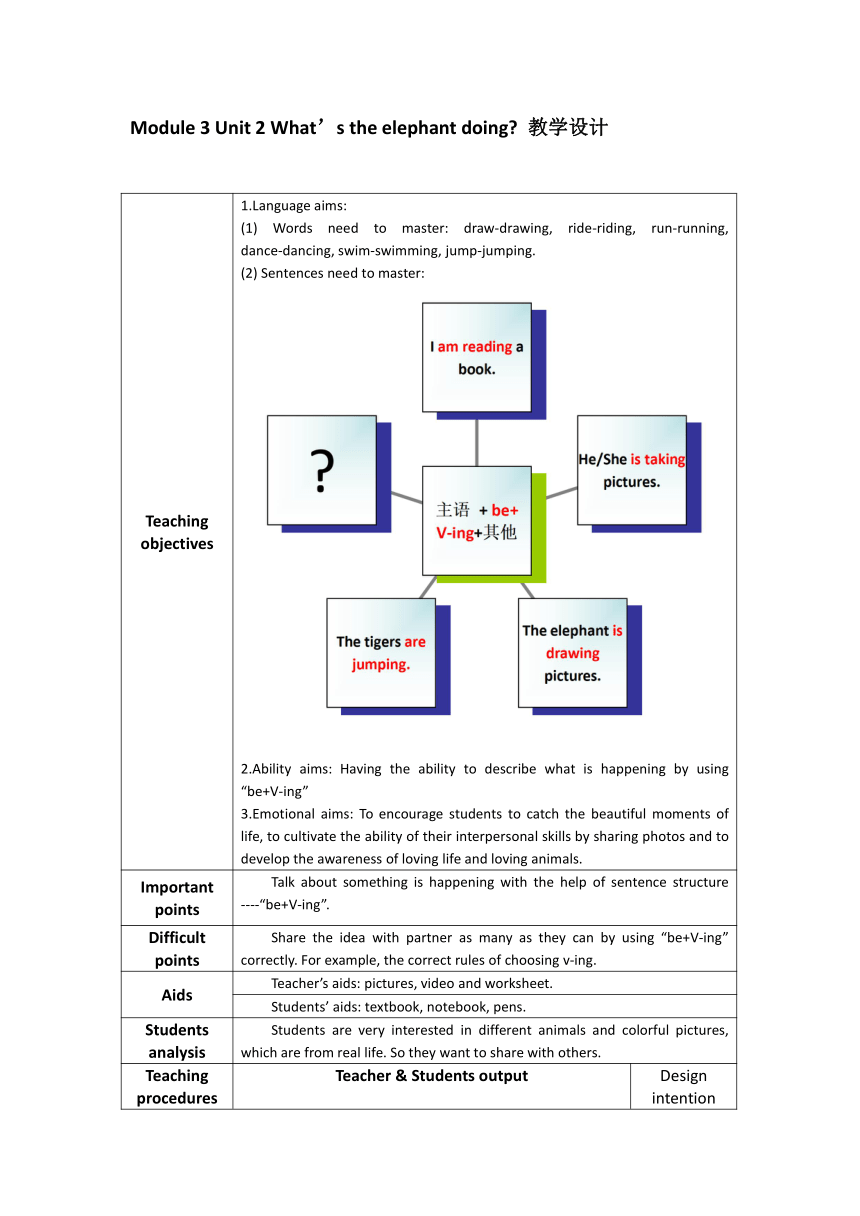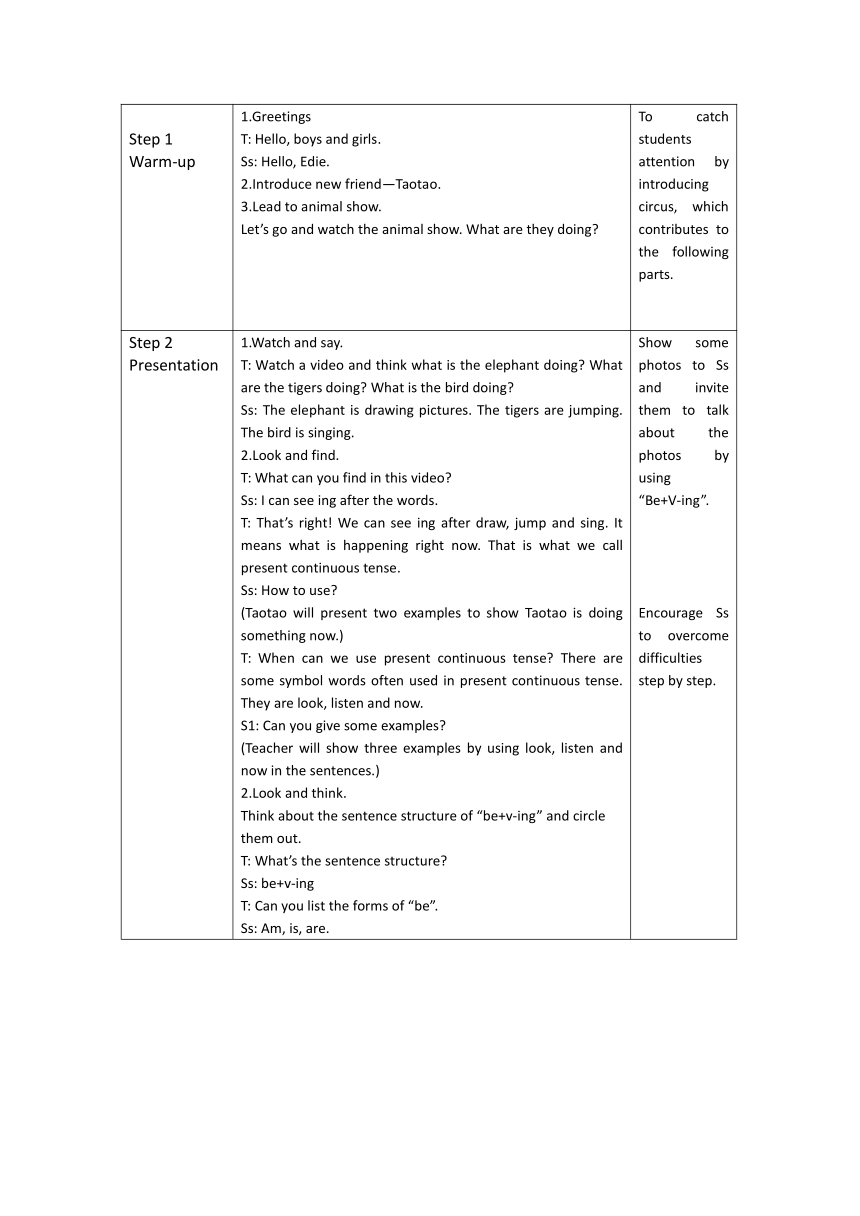Module 3 Unit 2 What’s the elephant doing 教学设计(表格)
文档属性
| 名称 | Module 3 Unit 2 What’s the elephant doing 教学设计(表格) |  | |
| 格式 | docx | ||
| 文件大小 | 5.3MB | ||
| 资源类型 | 教案 | ||
| 版本资源 | 外研版(三年级起点) | ||
| 科目 | 英语 | ||
| 更新时间 | 2023-06-08 23:37:29 | ||
图片预览


文档简介
Module 3 Unit 2 What’s the elephant doing 教学设计
Teaching objectives 1.Language aims: (1) Words need to master: draw-drawing, ride-riding, run-running, dance-dancing, swim-swimming, jump-jumping. (2) Sentences need to master: 2.Ability aims: Having the ability to describe what is happening by using “be+V-ing” 3.Emotional aims: To encourage students to catch the beautiful moments of life, to cultivate the ability of their interpersonal skills by sharing photos and to develop the awareness of loving life and loving animals.
Important points Talk about something is happening with the help of sentence structure ----“be+V-ing”.
Difficult points Share the idea with partner as many as they can by using “be+V-ing” correctly. For example, the correct rules of choosing v-ing.
Aids Teacher’s aids: pictures, video and worksheet.
Students’ aids: textbook, notebook, pens.
Students analysis Students are very interested in different animals and colorful pictures, which are from real life. So they want to share with others.
Teaching procedures Teacher & Students output Design intention
Step 1 Warm-up 1.Greetings T: Hello, boys and girls. Ss: Hello, Edie. 2.Introduce new friend—Taotao. 3.Lead to animal show. Let’s go and watch the animal show. What are they doing To catch students attention by introducing circus, which contributes to the following parts.
Step 2 Presentation 1.Watch and say. T: Watch a video and think what is the elephant doing What are the tigers doing What is the bird doing Ss: The elephant is drawing pictures. The tigers are jumping. The bird is singing. 2.Look and find. T: What can you find in this video Ss: I can see ing after the words. T: That’s right! We can see ing after draw, jump and sing. It means what is happening right now. That is what we call present continuous tense. Ss: How to use (Taotao will present two examples to show Taotao is doing something now.) T: When can we use present continuous tense There are some symbol words often used in present continuous tense. They are look, listen and now. S1: Can you give some examples (Teacher will show three examples by using look, listen and now in the sentences.) 2.Look and think. Think about the sentence structure of “be+v-ing” and circle them out. T: What’s the sentence structure Ss: be+v-ing T: Can you list the forms of “be”. Ss: Am, is, are. Ss: I 用 am, you 用 are, is 连着he, she, it. 单数主语用is, 复数主语都用are. 3.Listen and read. Ss: The cat is playing, the cats are sleeping. The panda is running, the pandas are singing. (To compare the different examples.) T: To change the v-ing form, can we add ing directly Ss: No. T: Here are some common ways. 1)jump-jumping, draw-drawing. 2)ride-riding, dance-dancing. 3)swim-swimming, run-running. 4)lie-lying. Show some photos to Ss and invite them to talk about the photos by using “Be+V-ing”. Encourage Ss to overcome difficulties step by step.
Step 3 Practice Practice “be-am/ is/are” Practice “v-ing” To encourage every student to join in the activity and to develop their ability of compare.
Step 5 Summary T: What did we learn today Ss: We learnt what is present continuous tense and some symbol words and its main structure “Be+V-ing”. To draw a conclusion what we learnt by using the mind map.
Teaching objectives 1.Language aims: (1) Words need to master: draw-drawing, ride-riding, run-running, dance-dancing, swim-swimming, jump-jumping. (2) Sentences need to master: 2.Ability aims: Having the ability to describe what is happening by using “be+V-ing” 3.Emotional aims: To encourage students to catch the beautiful moments of life, to cultivate the ability of their interpersonal skills by sharing photos and to develop the awareness of loving life and loving animals.
Important points Talk about something is happening with the help of sentence structure ----“be+V-ing”.
Difficult points Share the idea with partner as many as they can by using “be+V-ing” correctly. For example, the correct rules of choosing v-ing.
Aids Teacher’s aids: pictures, video and worksheet.
Students’ aids: textbook, notebook, pens.
Students analysis Students are very interested in different animals and colorful pictures, which are from real life. So they want to share with others.
Teaching procedures Teacher & Students output Design intention
Step 1 Warm-up 1.Greetings T: Hello, boys and girls. Ss: Hello, Edie. 2.Introduce new friend—Taotao. 3.Lead to animal show. Let’s go and watch the animal show. What are they doing To catch students attention by introducing circus, which contributes to the following parts.
Step 2 Presentation 1.Watch and say. T: Watch a video and think what is the elephant doing What are the tigers doing What is the bird doing Ss: The elephant is drawing pictures. The tigers are jumping. The bird is singing. 2.Look and find. T: What can you find in this video Ss: I can see ing after the words. T: That’s right! We can see ing after draw, jump and sing. It means what is happening right now. That is what we call present continuous tense. Ss: How to use (Taotao will present two examples to show Taotao is doing something now.) T: When can we use present continuous tense There are some symbol words often used in present continuous tense. They are look, listen and now. S1: Can you give some examples (Teacher will show three examples by using look, listen and now in the sentences.) 2.Look and think. Think about the sentence structure of “be+v-ing” and circle them out. T: What’s the sentence structure Ss: be+v-ing T: Can you list the forms of “be”. Ss: Am, is, are. Ss: I 用 am, you 用 are, is 连着he, she, it. 单数主语用is, 复数主语都用are. 3.Listen and read. Ss: The cat is playing, the cats are sleeping. The panda is running, the pandas are singing. (To compare the different examples.) T: To change the v-ing form, can we add ing directly Ss: No. T: Here are some common ways. 1)jump-jumping, draw-drawing. 2)ride-riding, dance-dancing. 3)swim-swimming, run-running. 4)lie-lying. Show some photos to Ss and invite them to talk about the photos by using “Be+V-ing”. Encourage Ss to overcome difficulties step by step.
Step 3 Practice Practice “be-am/ is/are” Practice “v-ing” To encourage every student to join in the activity and to develop their ability of compare.
Step 5 Summary T: What did we learn today Ss: We learnt what is present continuous tense and some symbol words and its main structure “Be+V-ing”. To draw a conclusion what we learnt by using the mind map.
同课章节目录
- Module 1
- Unit 1 Go straight on.
- Unit 2 It's at the station.
- Module 2
- Unit 1 She's reading a book.
- Unit 2 What are you doing?
- Module 3
- Unit 1 What are they doing?
- Unit 2 What's the elephant doing?
- Module 4
- Unit 1 Do you want some rice?
- Unit 2 How much is it?
- Module 5
- Unit 1 Can you ran fast?
- Unit 2 Can Sam play football?
- Module 6
- Unit 1 Can I have some sweets?
- Unit 2 Happy Halloween!
- Module 7
- Unit 1 There is a horse in this photo.
- Unit 2 There are twelve boys on the bike.
- Module 8
- Unit 1 We're going to visit Hainan.
- Unit 2 Sam is going to ride horse.
- Module 9
- Unit 1 Are you going to run on Sports Day?
- Unit 2 I'm going to do the high jump.
- Module 10
- Unit 1 We have a big family dinner.
- Unit 2 Merry Christmas!
- Review Module
- Unit 1
- Unit 2
